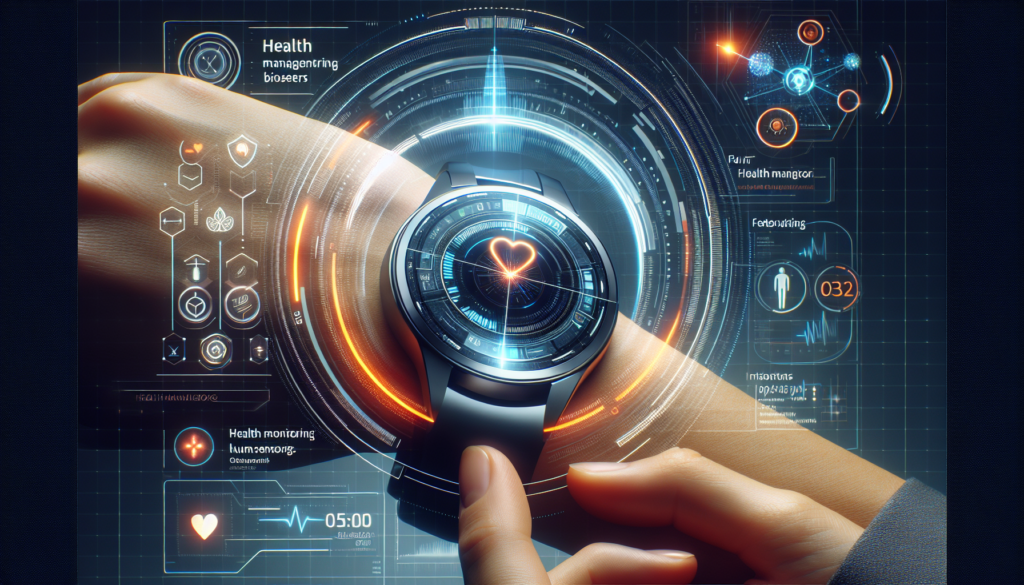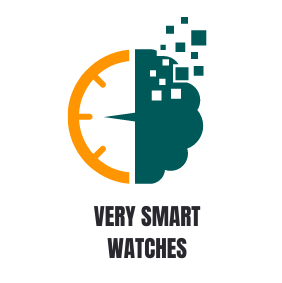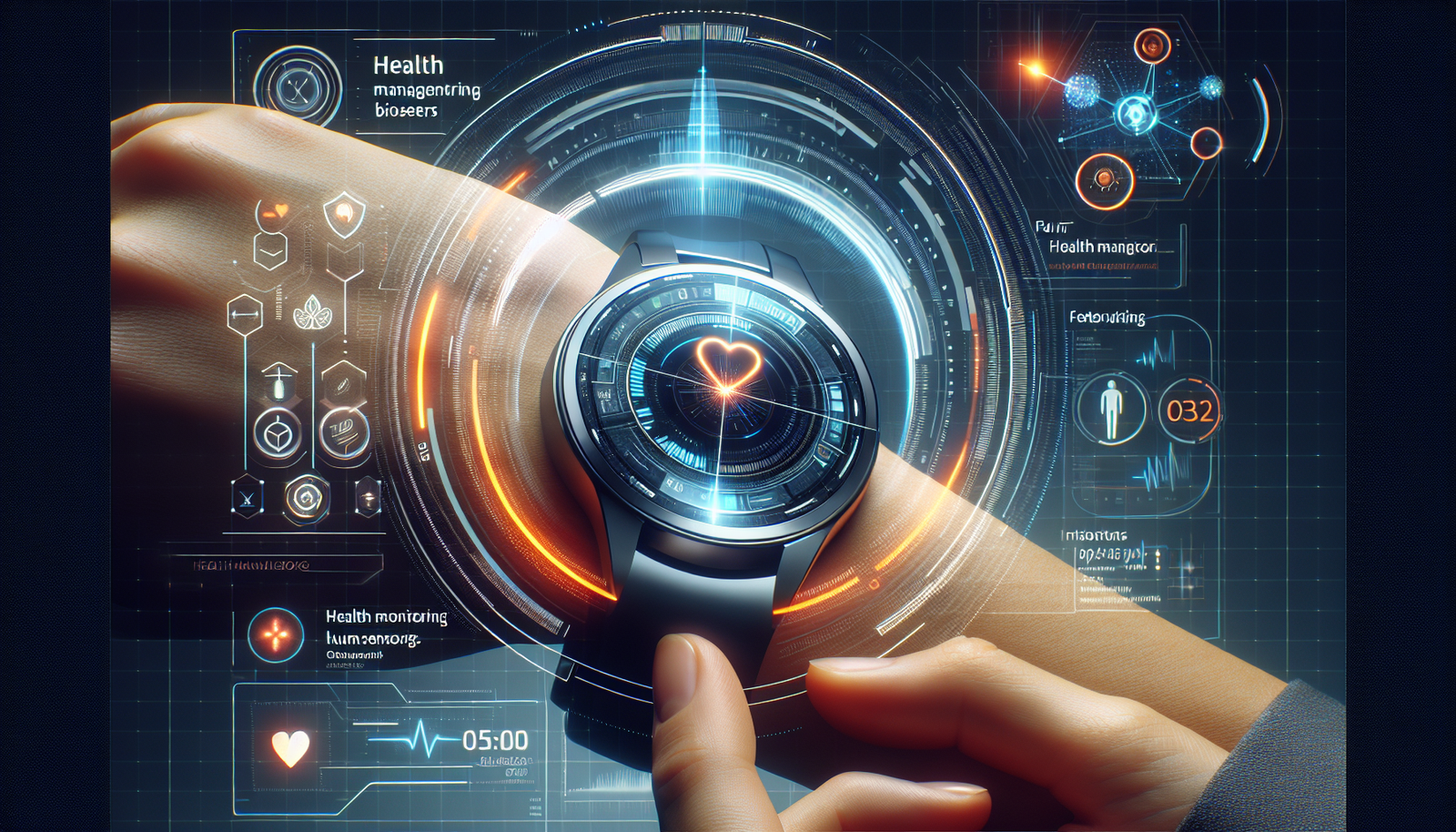Imagine a world where your health is just a glance away. Smartwatches are leading the charge in revolutionizing the future of health. Gone are the days of passive data collection; now, these innovative devices empower us to take control of our well-being. From wheelchair accessibility to mental well-being, they cater to diverse needs, ensuring that everyone can benefit from their features. Moreover, smartwatches are not just about tracking steps and heart rates; they go beyond that. Their language of personalized wellness dashboards, biohacking, and peak performance paves the way for a future where our health becomes a vibrant conversation. With smarter data interpretation and specialized accessories, smartwatches are shaping a future of wearable wellness that is accessible, inclusive, and ultimately, empowering.

I. Introduction
In recent years, smartwatches have emerged as a significant player in the world of wearable technology. These innovative devices have become increasingly popular, offering a range of features and functionalities that extend far beyond simply telling time. With their seamless integration with healthcare, smartwatches are revolutionizing the way we monitor our health and fitness. This article will explore the rise of smartwatches, advancements in health monitoring, health and fitness features, accessibility and inclusivity, proactive health monitoring, data interpretation and insights, personalization and customization, challenges and ethical considerations, as well as future possibilities and innovations.
II. The Rise of Smartwatches
A. Evolution of wearable technology
The evolution of wearable technology has paved the way for the rise of smartwatches. From the humble pedometers and fitness trackers of the past, we now have sophisticated devices that can track an array of health metrics and provide personalized insights. Smartwatches have become a natural progression in this evolution, offering a compact and stylish way to stay connected and monitor our well-being.
B. Smartwatches as a popular choice
With their sleek designs, advanced technology, and a plethora of features, smartwatches have quickly gained popularity among tech enthusiasts, fitness enthusiasts, and even the general population. The convenience of having a miniature computer on your wrist, capable of performing tasks like answering calls, sending messages, tracking fitness goals, and even making payments, has made smartwatches an appealing choice for many.
C. Increasing integration with healthcare
One of the most significant contributions of smartwatches is their increasing integration with healthcare. These devices have transformed into powerful health-monitoring tools that allow individuals to track various health metrics in real-time. Smartwatches have become a vital companion in promoting overall well-being by continuously monitoring heart rates, tracking sleep patterns, measuring blood oxygen levels, and even detecting abnormal health patterns. This integration with healthcare has the potential to empower individuals to take control of their own health and make informed decisions.
III. Advancements in Health Monitoring
A. Continuous heart rate monitoring
Smartwatches now offer continuous heart rate monitoring throughout the day. By utilizing advanced sensors, these devices can accurately measure your heart rate, providing valuable insights into your overall cardiovascular health. This feature is particularly useful for individuals who want to monitor and optimize their fitness training or maintain awareness of any irregularities in their heart rate.
B. Sleep tracking and analysis
Tracking and analyzing sleep patterns have become a standard feature in modern smartwatches. By wearing a smartwatch while you sleep, it can monitor your sleep duration, track various sleep stages, and provide valuable insights into the quality of your sleep. This information can help you make adjustments to your sleep routine and improve your overall sleep hygiene.
C. Blood oxygen level monitoring
Smartwatches equipped with SpO2 sensors can now monitor blood oxygen levels. This feature enables individuals to keep an eye on their oxygen saturation levels, which is crucial for those with respiratory conditions or individuals who engage in high-altitude activities. By regularly monitoring blood oxygen levels, individuals can ensure they are maintaining optimal health and take necessary actions if levels fall below normal.
D. ECG and arrhythmia detection
Some smartwatches now include the ability to perform electrocardiograms (ECGs) right from your wrist. ECGs can detect abnormal heart rhythms and even help diagnose conditions like atrial fibrillation. This feature provides users with early detection and the possibility of seeking immediate medical attention, potentially preventing serious health complications.
E. Stress tracking and management
Many smartwatches now incorporate stress tracking features to help individuals manage their mental well-being. By measuring various physiological signals such as heart rate variability, these devices can provide insights into your stress levels throughout the day. Armed with this information, users can practice stress management techniques and make lifestyle adjustments to improve their overall mental health.
IV. Health and Fitness Features
A. Personalized wellness dashboards
Smartwatches offer personalized wellness dashboards that consolidate all your health and fitness data in one place. These dashboards provide a comprehensive overview of your daily activity, sleep patterns, heart rate, and other vital metrics, allowing you to easily monitor your progress towards your health and fitness goals. This visual representation of your data empowers you to make informed decisions about your well-being.
B. Activity and exercise tracking
Smartwatches excel in tracking various forms of physical activity and exercise. From counting steps and estimating calorie burn to recognizing specific exercises and providing personalized feedback, these devices help individuals stay motivated and adhere to their fitness routines. Whether you are walking, running, swimming, cycling, or engaging in other physical activities, smartwatches can accurately track and analyze your performance.
C. Coaching and virtual trainers
Some smartwatches offer coaching and virtual trainers, providing users with personalized guidance and motivation to reach their fitness goals. Whether it’s through pre-recorded workout routines or real-time feedback during exercise, these features simulate the experience of having a personal trainer right on your wrist. The coaching aspect of smartwatches encourages individuals to push their limits and achieve their desired level of fitness.
D. Gamification for motivation
Smartwatches often employ gamification techniques to motivate users and make the journey towards better health and fitness more enjoyable. By rewarding users with badges, achievements, and virtual challenges, these devices turn daily activities into fun competitions. Gamification not only enhances user engagement but also fosters a sense of community as individuals can connect and compete with friends and family.

V. Accessibility and Inclusivity
A. Catering to wheelchair accessibility
Smartwatches are becoming more inclusive by enhancing their features to cater to individuals with wheelchair accessibility needs. This includes optimized activity tracking algorithms that accurately measure movements while using a wheelchair. By providing accurate data specific to wheelchair use, individuals can monitor their physical activity, set goals, and receive tailored feedback that is relevant to their unique circumstances.
B. Supporting visual impairment
Smartwatches have made significant strides in supporting individuals with visual impairments. Through voice assistants and haptic feedback, these devices enable visually impaired users to navigate the interface, access important health information, and interact with various features. Additionally, smartwatches with braille displays are being developed, further enhancing accessibility for the visually impaired community.
C. Assisting with mental well-being
Recognizing the importance of mental well-being, smartwatches offer features that assist individuals in managing their mental health. These features may include guided breathing exercises, mindfulness reminders, and even mood tracking. By incorporating mental well-being into their functionalities, smartwatches aim to provide individuals with the tools they need to maintain emotional balance and overall wellness.
D. Addressing specific health conditions
Smartwatches now cater to individuals with specific health conditions by offering specialized features. For example, some smartwatches are equipped with medication reminders for individuals managing chronic illnesses. Others may have seizure detection alerts or allergy tracking capabilities. By addressing the unique needs of individuals with specific health conditions, smartwatches contribute to improved health management and overall quality of life.
VI. Proactive Health Monitoring
A. Early detection of pre-diabetes
Smartwatches equipped with continuous glucose monitoring technology now have the potential to detect early signs of pre-diabetes. By tracking blood glucose levels throughout the day, these devices provide insights into the body’s response to food and exercise. Individuals can use this information to make dietary adjustments and lead a healthier lifestyle, potentially preventing the onset of diabetes.
B. Body temperature monitoring
Smartwatches have started incorporating body temperature monitoring as a way to detect abnormal health patterns. By regularly monitoring body temperature, these devices can detect fevers and other anomalies that may indicate the presence of an underlying health condition. Early detection of abnormal temperature patterns can prompt individuals to seek medical attention, leading to timely intervention and improved health outcomes.
C. Detecting abnormal health patterns
Smartwatches equipped with advanced algorithms can analyze health data and detect abnormal patterns that may indicate potential health issues. For example, sudden spikes or dips in heart rate, unusual sleep patterns, or even changes in activity levels can be indicators of underlying health conditions. By proactively monitoring and identifying these patterns, smartwatches empower individuals to take prompt action and seek appropriate medical attention.
D. Health notifications and reminders
Smartwatches can send notifications and reminders to encourage users to stay on top of their health and engage in healthy behaviors. These reminders can include drinking water, taking medication, standing up and moving around, or even performing breathing exercises. By providing gentle nudges, smartwatches help individuals establish healthy habits and maintain overall well-being.
VII. Data Interpretation and Insights
A. Machine learning algorithms
Smartwatches utilize machine learning algorithms to interpret the vast amount of health and fitness data they collect. These algorithms learn from users’ data patterns and provide insightful recommendations tailored to each individual’s needs. As the algorithms continue to improve and learn from more data, the accuracy and relevance of the recommendations will also increase.
B. Contextual data analysis
Smartwatches analyze health data within the context of an individual’s lifestyle and habits. By considering factors such as stress levels, activity patterns, sleep quality, and personal goals, these devices can provide meaningful insights that resonate with the user’s unique circumstances. This contextual analysis allows for more personalized and relevant recommendations, further empowering individuals to make positive changes in their health and lifestyle.
C. Personalized health recommendations
With their ability to interpret data and analyze patterns, smartwatches can provide personalized health recommendations. Whether it’s suggesting specific exercises, reminding individuals to take breaks, or providing nutritional guidance, these devices leverage user data to offer tailored advice. Personalized recommendations help users make informed decisions, leading to a more effective and efficient path towards improved health and well-being.
D. Predictive analytics for early intervention
By leveraging predictive analytics, smartwatches can detect patterns and identify potential health issues even before symptoms arise. These devices can analyze historical data, lifestyle habits, and other relevant factors to predict future health risks. With early intervention, individuals can take proactive steps to mitigate these risks and make necessary adjustments to their lifestyles, ultimately preventing health complications.
VIII. Personalization and Customization
A. Interchangeable bands and accessories
Smartwatches offer interchangeable bands and accessories, allowing users to personalize their devices to suit their style and preferences. This level of customization ensures that smartwatches seamlessly blend into users’ lives, becoming an integrated part of their daily routines. Whether it’s a sleek metal band for a formal occasion or a vibrant silicone band for a workout session, users can choose accessories that suit their mood and activities.
B. Watch faces and widgets
In addition to interchangeable bands, smartwatches provide a range of watch faces and widgets that allow users to further personalize their devices. From classic analog faces to vibrant digital displays, users can select the visual style that speaks to them. Widgets also offer customization options, displaying relevant information such as weather updates, upcoming calendar events, or even real-time health data on the watch face for quick access.
C. Integration with third-party apps
Smartwatches can integrate with various third-party apps, expanding their functionalities and allowing users to access a wide range of additional features. Whether it’s fitness apps, meditation apps, healthcare platforms, or even music streaming services, the integration with third-party apps enhances user experience and enables individuals to tailor their smartwatch to suit their specific needs and preferences.
D. Syncing with other devices and platforms
Smartwatches seamlessly sync with other devices and platforms, ensuring a cohesive user experience across multiple devices. By enabling synchronization with smartphones, tablets, and even smart home devices, smartwatches become central hubs for health and fitness data. This synchronization allows users to access their data from various devices, track progress, and make adjustments whenever and wherever they choose.
IX. Challenges and Ethical Considerations
A. Privacy and data security
As smartwatches collect and store vast amounts of personal health data, privacy and data security become essential considerations. Manufacturers must ensure that robust security measures are in place to protect users’ data from unauthorized access or breaches. Additionally, clear privacy policies and user consent mechanisms should be in place to ensure transparency and give individuals control over their data.
B. Accuracy and reliability of health data
The accuracy and reliability of the health data collected by smartwatches are crucial for individuals to make informed decisions about their health. Manufacturers need to invest in research and development to improve sensor accuracy and data quality. Regular calibration and verification of sensors are essential to ensure that the data provided is accurate and reliable.
C. User dependency and potential over-reliance
While smartwatches offer valuable health insights, there is a risk of users becoming overly dependent on the device. Individuals should maintain a balance between utilizing smartwatches as health tools and seeking professional medical advice when necessary. Manufacturers should educate users about the limitations of smartwatches and emphasize the importance of professional healthcare guidance.
D. Ethical implications of health monitoring
Smartwatches raise important ethical considerations related to health monitoring. The collection and analysis of personal health data can potentially be used for purposes beyond the individual’s consent, such as insurance or employment discrimination. Therefore, manufacturers and policymakers must work together to establish clear ethical guidelines that protect users’ rights and ensure responsible use of health data.
X. Future Possibilities and Innovations
A. Advanced sensors and biometrics
Future smartwatches will likely incorporate more advanced sensors and biometric capabilities. These devices may be capable of tracking additional health metrics such as blood pressure, sweat composition, or even monitoring specific biomarkers. Advanced sensor technology will provide users with even more comprehensive health data, allowing for a deeper understanding of their overall well-being.
B. Integration with augmented reality (AR)
The integration of smartwatches with augmented reality (AR) holds immense potential for health and wellness applications. AR can provide users with real-time feedback during workouts, offer immersive coaching experiences, or even overlay medical information onto the real world for healthcare professionals. By merging the capabilities of smartwatches and AR technology, the possibilities for enhancing health and wellness experiences are endless.
C. Telemedicine and remote patient monitoring
Smartwatches can play a significant role in telemedicine and remote patient monitoring. With advanced sensors and real-time data transmission capabilities, smartwatches can enable healthcare professionals to monitor patients remotely, provide timely interventions, and gather valuable health data. This has the potential to improve access to healthcare, especially for individuals in remote areas or those with limited mobility.
D. Collaboration with healthcare professionals
Smartwatches will increasingly collaborate with healthcare professionals to provide more personalized and seamless care. Integration with electronic health records (EHRs) and telehealth platforms will allow healthcare providers to access real-time patient data and provide targeted interventions. By fostering collaboration between smartwatches and healthcare professionals, the future of healthcare will be driven by data-driven decision-making and proactive interventions.
In conclusion, smartwatches have revolutionized the way we monitor our health and fitness. These devices have evolved from simple time-telling accessories to sophisticated health-monitoring tools that empower individuals to take control of their well-being. With continuous advancements in health monitoring, personalized features, accessibility and inclusivity, and proactive health monitoring, smartwatches are paving the way for a future where wellness becomes an intimate and comprehensive conversation. As technology continues to evolve, smartwatches will play an even more significant role in shaping the future of healthcare, further enhancing our ability to live healthier and more fulfilling lives.

